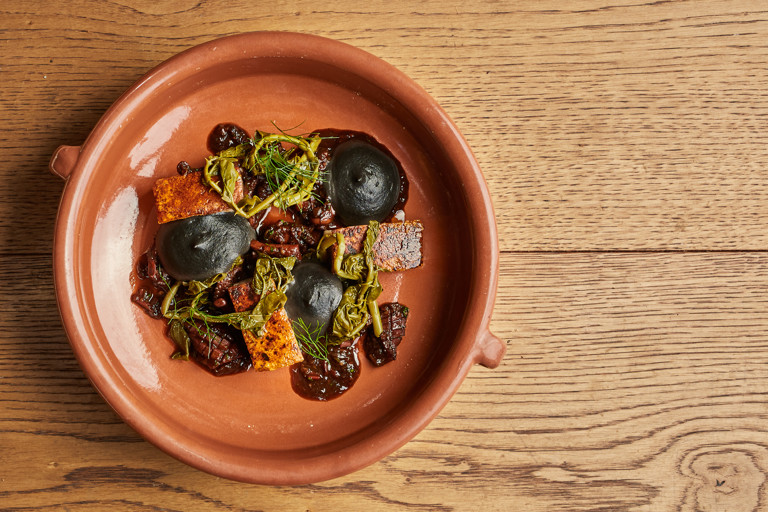Pork belly with squid 'krassado' and squid ink mash
Item 1 of 1
- 6
- 2 hours
A beautiful Mediterranean dish full of bold flavours that taste like you're on holiday, the real work in this dish is making the pork belly, which needs to be cured, slow-cooked and pressed over several days in preparation for crisping up just before serving. Paired with an intense squid stew full of Greek/Cypriot flavours and a black squid ink mash, the dish is finished with pickled caper leaves – a speciality of Cypriot cuisine.
George uses an espuma gun to aerate the mash, but if you don't have one you can serve it without aerating too.
First published in 2020
Ingredients
Metric
Imperial
Pork
- 500g of pork belly
- 300g of rock salt
- 1 tsp ground cinnamon
- 1 tsp cloves, crushed
- 10 garlic cloves, chopped
- 1/2 bunch of fresh thyme
- 1 tsp black peppercorns, crushed
- 500g of duck fat
Krassado
- 500g of squid, cleaned
- 2 tbsp of tomato purée, George uses Datterini tomato paste
- 500ml of red wine
- 300ml of white wine vinegar
- 500g of white chicken stock
- 1 cinnamon stick
- 3 cloves
- 1/2 tsp coriander seeds
- 1 bay leaf
- 200g of banana shallot, finely chopped
- 3 garlic cloves, finely chopped
- 3 plum tomatoes, peeled, seeds removed and finely chopped (or you can use tinned plum tomatoes for ease, if preferred)
- 4 sprigs of lemon thyme
- sea salt
- fennel fronds, or coriander leaves, to garnish
- pickled caper leaves, to garnish
Squid ink mash
- 1 squid ink sachet
- 250g of mashed potatoes
- 150g of semi-skimmed milk
- 20g of unsalted butter
- sea salt
- ground white pepper
- 3g of Sosa ProEspuma, Hot (optional)
SAVE RECIPE
Method
1
The pork for this dish takes several days to make, so prepare accordingly. Mix together the salt, cinnamon, cloves, garlic, thyme and peppercorns, then use this to coat the pork belly, rubbing it in and ensuring the meat is completely covered. Place in a tray in the fridge and leave to cure for 6 hours, turning the meat every 2 hours to ensure an even cure
- 300g of rock salt
- 1 tsp ground cinnamon
- 1 tsp cloves, crushed
- 10 garlic cloves, chopped
- 1/2 bunch of fresh thyme
- 1 tsp black peppercorns, crushed
- 500g of pork belly
2
After 6 hours, preheat an oven to 85°C. Rub off the salt mixture and pat dry. Place in a deep pan and pour over enough duck fat to just cover the meat. Leave to cook for 6 hours (or ideally overnight) until very tender
- 500g of duck fat
3
Carefully lift the pork out of the duck fat and press between 2 baking trays with weights on top. Leave in the fridge to cool and set for several hours – you will finish off cooking the pork just before serving
4
For the krassado, score a criss-cross pattern into the squid and cut into bite-sized pieces. Preheat an oven to 170°C/gas mark 3 and place a large saucepan over a medium heat. Place the tomato paste onto a baking tray, drizzle over a little olive oil then place in the oven to cook and dry out for 15 minutes (ensure it doesn’t burn)
- 500g of squid, cleaned
- 2 tbsp of tomato purée, George uses Datterini tomato paste
5
Meanwhile, add a dash of olive oil to the saucepan and cook the shallots and garlic until sweet and lightly golden. Add the chopped tomatoes, thyme and spices, cook for a minute or 2, then drain any excess fat from the pan. Add the dried-out tomato paste and vinegar, then simmer for 30 minutes until the vinegar has heavily reduced into a glaze
- 200g of banana shallot, finely chopped
- 3 garlic cloves, finely chopped
- 3 plum tomatoes, peeled, seeds removed and finely chopped (or you can use tinned plum tomatoes for ease, if preferred)
- 4 sprigs of lemon thyme
- 1 cinnamon stick
- 3 cloves
- 1/2 tsp coriander seeds
- 1 bay leaf
- 300ml of white wine vinegar
7
While the stew simmers, prepare the squid ink mash. Place the mashed potato, butter and milk in a saucepan and warm through, ensuring they are very well mixed. Season, then add enough squid ink to turn the mixture black. At this point, you can either serve the mash as is, or mix in the proespuma hot, pass the mixture through a sieve and charge in an espuma gun. Either way, keep warm until ready to serve
- 250g of mashed potatoes
- 20g of unsalted butter
- 150g of semi-skimmed milk
- sea salt
- ground white pepper
- 1 squid ink sachet
- 3g of Sosa ProEspuma, Hot (optional)
8
When ready to serve, cut the pressed pork belly into neat rectangles and render the fat from the skin in a hot pan. Flip the pork belly, then finish off the skin under a hot grill until very crisp. Meanwhile, ensure the squid ink mash is hot and the squid is very tender
9
To plate, place pieces of pork belly in the base of a bowl. Spoon the squid krassado around the pork belly pieces, then add spoonfuls of mash (or pipe the foam, if using an espuma gun) in between. Garnish with the pickled caper leaves and fennel fronds, then serve immediately
- fennel fronds, or coriander leaves, to garnish
- pickled caper leaves, to garnish
First published in 2020
Get in touch
Please sign in or register to send a comment to Great British Chefs.



